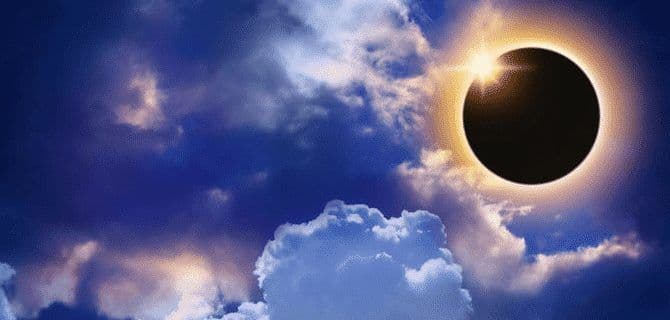On August 21, 2017, and for the first time in almost a century, the magnificent sight of the moon passing over and completely covering the sun will be visible across parts of North America. In Washington D.C., during the ACS National Meeting, the sky will briefly darken with an estimated 81% obscuration of the sun.[i] […]

On August 21, 2017, and for the first time in almost a century, the magnificent sight of the moon passing over and completely covering the sun will be visible across parts of North America. In Washington D.C., during the ACS National Meeting, the sky will briefly darken with an estimated 81% obscuration of the sun.[i] But while the solar eclipse has many Americans giddy with anticipation and excitement, there are definitely a group of people with serious concerns about this celestial event. Who are these people that are concerned about the solar eclipse? Ophthalmologists!
Why do eye doctors view the upcoming solar eclipse as dangerous?
It is because sun-gazing comes with serious and sometimes catastrophic risks to our eyesight. The damage is known as solar retinopathy.[ii] Symptoms of this damage include blind spots, distortions, loss of contrast in your central vision, and difficulty with common tasks such as reading, driving, and typing on the computer.
Solar retinopathy belongs to a class of injuries known as photic retinopathy, which also include laser eye injuries, and welding eye injuries. These injuries often involve damage to an important portion of the retina known as a macula, where specialized cells in our retina[iii] transduce light energy into a chemical signal via a photolysis reaction in which 11-cis-retinal is photolyzed into all-trans-retinal. (For the latest research techniques examining the process of photolysis,[iv] visit our newest journal, ACS Earth and Space Chemistry.) To see a graphic describing the photochemical reaction that happens in the eye during sun damage, see this recent article in C&EN.
Contrary to popular belief, much of the damage caused by solar retinopathy is not due to the thermal effect from concentrated light rays. In fact, much of the injury to the retina is caused by a photochemical reaction in which high energy light rays induce oxidation and free radical formation. The retina is an area of our body that is rich in oxygen and oxidative stress. Fortunately, we have specialized cells in a special layer of our retina known as the retinal pigment epithelium (RPE) that contain melanosomes which absorb scattered light energy and minimize oxidative stress. [v],[vi] However, the intense rays of the sun, certain lasers, ultraviolet light from arc welders, and other sources can quickly overwhelm the protective functions of the RPE and lead to the formation of free radicals which bond with important proteins in our retina and damage our vision. This phototoxic chemical reaction is why people who develop eye damage watching a solar eclipse often report severe vision difficulties the day after an eclipse and not immediately during the viewing.
How can we enjoy the solar eclipse without putting our eyes at risk for solar retinopathy?
Physicians recommend using certified eclipse glasses. For effective eclipse glasses, look for a certification from the International Organization for Standardization. There should be an ISO 12312-2 or ISO 12312-2:2015 marking.[vii] Be careful of glasses that claim to be solar safe but don’t have certified markings. And solar eclipse gazers should take breaks and try not to stare from the same angle at the sun for too many seconds at a time.
And while on the topic of eye safety, ACS’s Division of Chemical Health and Safety is a strong advocate and resource for eye safety. Some related ACS safety recommendations include those for eye protection for students in chemistry laboratories[viii] and eye protection recommendations for small businesses and their employees.[ix]
Enjoy the complete solar eclipse on August 21st
The solar eclipse promises to be a spectacular, once-in-a-lifetime event. But avoid the phototoxic reaction to your retina by wearing ISO 12312 certified solar glasses. That’s one reaction ACS doesn’t endorse!
If you’re attending the ACS National Meeting, you can pick up a pair of protective eyewear at the Attendee Resources Area at the Walter E. Washington Convention Center or at the Operations Offices at hotels while supplies last.
[i] http://cen.acs.org/articles/95/i29/One-eclipse-cosmos-beyond.html.
[ii] Chen, K. C.; Jung, J. J.; Aizman, A. Solar Retinopathy: Etiology, Diagnosis, and Treatment. Retinal Physician 2013, 10, 46–50.
[iii] Kolb, Helga. Simple Anatomy of the Retina. The Organization of the Retina and Visual System [Internet]; University of Utah Health Sciences Center: Salt Lake City (UT), 1995.
[iv] Mangiante, D. M.; Schaller, R. D.; Zarzycki, P.; Banfield, J. F.; Gilberrt, B. Mechanism of Ferric Oxalate Photolysis. ACS Earth Space Chem. 2017, 1, 270-276.
[v] Organisciak, D. T., Vaughan, D. K. Retinal light damage: mechanisms and protection. Prog. Retinal Eye Res. 2010, 29, 113-34.
[vi] Youseff, P. N.; Sheibani, N.; Albert, D. M. Retinal light toxicity. Eye (London, U.K.) 2011, 25, 1-14.
[vii] Eye and face protection — Sunglasses and related eyewear — Part 1: Sunglasses for general use, ISO 12312-1:2013; International Organization for Standardization: Geneva, Switzerland, 2013.
[viii] Safety in Academic Chemistry Laboratories: Best Practices for First- And Second-Year University Students, 8th Ed.; American Chemical Society: Washington, DC, 2017.
[ix] Chemical Safety Manual for Small Businesses: Guides for Managers, Administrators, and Employees, 3rd Ed.; American Chemical Society: Washington, DC, 2007.